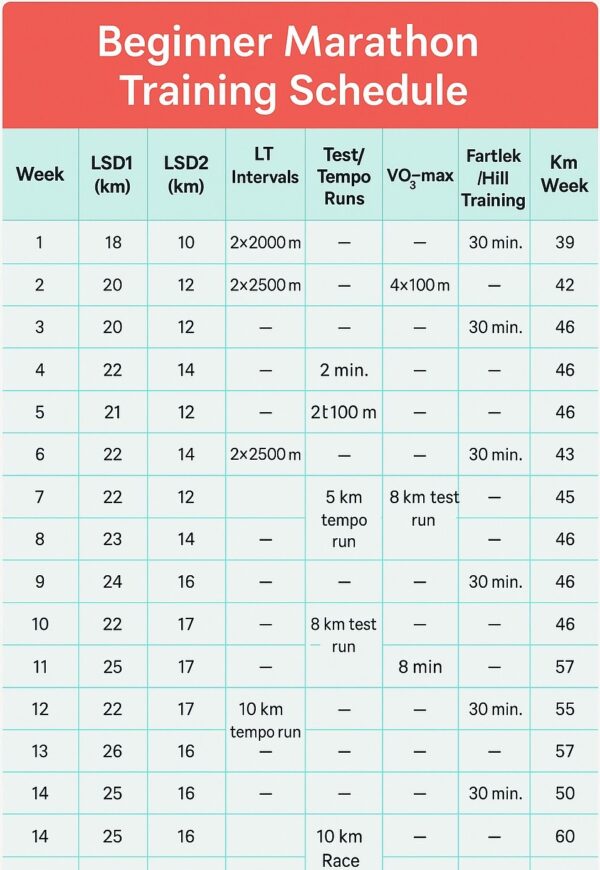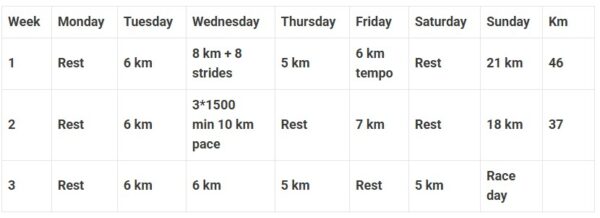There’s a moment in every runner’s life when a whisper becomes a promise: “I’m going to run a marathon.” That moment changes you. Whether you’re new to distance running or stepping up your commitment, this beginner marathon training schedule is more than a plan — it’s a companion. It blends structure, heart, and hard-won experience to guide you step-by-step. Inside, you’ll find not just miles and workouts, but motivation, mindset, and the emotional truth behind finishing strong.

🐢 Slow & Steady: Long Slow Distance (LSD 1 & LSD 2)
When I first started running long, slow distance runs, I thought slower meant “worse.” I couldn’t have been more wrong. These long sessions taught me patience, mindfulness, and how to enjoy solitude. The idea isn’t to exhaust yourself—it’s to develop your aerobic engine slowly and steadily.
I learned to leave my watch at home sometimes, focusing on how I felt rather than looking at numbers. Over time, what was once my slow pace became my new normal. Running these at “conversation pace” also helped me bond with training partners and reflect during solo sessions.
Most runners I know who finish a marathon strong have consistently respected their LSD days.
Understanding the beginner marathon training schedule means valuing base miles. LSD 1 & LSD 2 keep your heart rate low (Zone 2), training endurance without stress. I learned patience here—the runs felt easy at first, but over weeks my legs got stronger, my pace gently improved, and my confidence soared.
⚡️ Push the Limit: Lactate Threshold (LT) Training
One of the biggest turning points in my training was learning how to run comfortably hard. That’s what LT training is all about—not sprinting, but pushing just below the red line for a sustained effort.
I remember finishing my first real 30-minute tempo run and feeling both exhausted and proud. These runs were emotionally tough at first, but they taught me mental discipline.
They’ve also become my secret weapon—if you can hold your LT pace during training, you’ll be able to manage discomfort much better during the race. You’re not just training your legs here—you’re sharpening your mind too.

LT training—around half-marathon pace—challenges your muscles to buffer lactic acid. I remember the burn at 30 minutes into a tempo run… but each one left me stronger. For recovery, walk or jog lightly afterwards.
🧪 Test Your Progress: Test Runs & Races
If you’ve ever felt unsure whether you’re “ready,” a test race will answer that. I once signed up for a 10K five weeks before marathon day. I wasn’t trying to win—it was all about checking my pacing, nerves, hydration, and fueling. That race gave me data and, more importantly, confidence.
Shorter races like these help you simulate race conditions: gear, routines, energy gels, even bathroom strategies! Don’t treat test races like perfection trials. Use them to practice everything, from tying your shoes to controlling your race day jitters. Each one gives you valuable feedback—and a dose of healthy adrenaline.
These mini-races (5 km–10 km) are my compass—they told me if I was on track or needed a pace reset. They also sharpen your mental grit—running crowded start-lines is practice for race day adrenaline.
👟 Right Shoes: Choose Your Marathon Training Shoes
I’ll admit—I didn’t realize how much my shoes mattered until I ran my first interval session in a clunky pair. Switching to lightweight trainers felt like flying. Not only did I shave time off my splits, but I also felt less soreness the next day. Comfort, weight, and responsiveness really do make a difference on your key runs.

The lightweight, responsive type of shoes became my go-to for speed sessions. They felt like an extension of me—no bulk, just connected footstrike and forward drive.
🔥 Boost Endurance: VO2‑Max & High‑Intensity Training
This type of training scared me at first. I had read about “VO2 max intervals” and assumed they were for elite runners. But after my coach introduced me to 3-minute repeats with equal recovery, I felt something shift. They were hard, no doubt—but the recovery jogs helped me manage them mentally.
The truth is, you don’t need a lab test to improve your VO2 max. You need consistency, courage, and a stopwatch. These sessions pushed me out of my comfort zone—and I learned I was stronger than I thought. They made marathon pace feel sustainable, even relaxed.

Intervals near VO2‑Max (80–95% effort) sharpen your aerobic ceiling. I alternated 4‑minute hard runs with 2–3‑minute jog recoveries. These were brutal but rewarding—my breathing got stronger, my pace skyrocketed.
🌳 Playful Speed: Fartlek & Hills
Fartlek became my favorite run of the week. After days of structure, pace zones, and heart rate monitoring, fartlek was freedom. I’d run fast to the next lamppost, then recover until the next mailbox. There’s joy in unpredictability—it reminds you why you started running.
On the other hand, hills built toughness. They didn’t just train my legs; they toughened my mindset. I’d often whisper, “one more step” on steep climbs. Those sessions, short as they were, made me feel invincible. Together, fartlek and hill runs gave me variety, confidence, and a break from monotony. They also trained my stride and rhythm—skills essential on race day.

🗓️ 14‑Week Beginner/Intermediate Marathon Training Schedule
It’s important to remember this schedule isn’t set in stone. It continues from the basic training. Some weeks, life happens—you might be tired, sick, or just mentally off. That’s okay. What matters most is your body’s response over time. I always listen to signals like increased soreness, disrupted sleep, or emotional fatigue—these are signs you might need to adjust.
Use the schedule as a blueprint, not a rigid rulebook. Progress isn’t linear, and skipping one workout won’t ruin your race. In fact, honoring your recovery needs is a sign of a mature runner. Adapt the plan to your reality—and you’ll stay on track.

Allowing small adjustments:
-
Easy runs fill leftover days to reach weekly km.
-
Adjust tempo or interval distances as needed.
-
Rest days = sacred. I always gave my body peace on rest days.
🧘 Marathon Tapering: Final 3 Weeks
The taper taught me one of the hardest lessons: trusting the work I had already done. It felt strange to run less after so much effort. I’d worry I was losing fitness. But during taper, your muscles rebuild stronger, your glycogen stores replenish, and your energy returns.
Emotionally, I used these weeks to visualize race day, prepare gear, and reflect on how far I’d come. I also practiced gratitude—I’d write down one thing each day that training taught me. By race morning, I wasn’t just ready—I was grateful and calm.
Marathon Tapering Schedule
Below is the tapering schedule for 3 weeks to complete after the 14 weeks above.

Explain taper: decrease volume, maintain intensity. Share emotional rollercoaster—my legs felt sluggish early, then I woke race morning feeling ready
✅ Final Thoughts
Your journey to the marathon finish line is built on small, consistent steps—LSD runs, tempo efforts, VO2 intervals, and playful fartleks. Trust the schedule—and more importantly, trust your own resilience. I’ve lived each step, felt each ache and triumph, and I’m cheering you on. You’ve already taken the first step by reading this. Keep going—you’ve got this!
🧠 FAQ (Quick Answers)
-
How many rest days per week?
1–2 easy rest days are recommended to allow recovery and avoid injury. -
Can I swap workouts?
Yes—flexibility is okay. Just keep your key sessions (tempo, VO2) and LSD long runs in the correct order. -
What if I miss a week?
Don’t panic. Rejoin the training plan the following week—nothing permanently lost. -
How do I know I’m ready for marathon distance?
If you can complete the longest 32 km as described, feel recovered, and enjoy the process—you are ready.
📝 Summary Quote
“Every sunrise run built my strength—and every tempo run built my belief. Your marathon journey is not just physical, it’s emotional—trust each step.”
If this guide lifts your spirits or inspires your training, please share it with fellow runners!📤






Thank you for sharing this training schedule. Sometimes life is just so hectic and I have the marathon coming, the schedule will be very handy to have so I can make that I am staying on track for the upcoming marathon. Hopefully, after this covid-19 all the marathons will go back to normal. Will share you post to all my friends who are runners.
Thank you for your comments. Life was also hectic to me until I was sent home because of Corona and everything was closing down. So I decided to write about marathon training sitting here alone. But this Covid-19 is only temporary and things will go normal again. Today we can run outside at least in my country but maybe we should chose the woods or other places to run alone as I prefer.
Hey there,
I’ve never actually ran a marathon but I would like to. The furthest I‘ve ran so far is 5k and that had my legs feeling like jelly haha. It seems very organised and I know where to start now. It’s also more motivating to follow a plan so I will give it a go. Your plan is very clear and it’s easy to see the progression that I should be making throughout the training. Thanks for the information.
Robert
Thank you for the comments. The most important when starting running is to know your starting point and then take it from there. 5k was maybe a little too much as starting point
This is exactly what I was looking for (more than I was looking for actually). A clear, step-by-step, action-oriented schedule to help me become marathon worthy. I loved the detail, the tips, and straight forward instructions this one contains. I’ve already bookmarked it and I will print it out later today.
I mean, I’m so happy I stumbled upon this. I truly appreciate you devoting the time and expertise to create this. Now, it’s just doing the grueling work. And that I feel I can manage.
From the bottom of my heart, thank you.
Thank you for the comments. I’m happy than it’s something you can use and that you say “that I feel I can manage”… You got it.
Be well
nice artilcle. I have a cousin who runs maraton races and has a dream to become one of the best but it has really been challenging for his as his body does not let him be what he wants to be and it has been really depressing for him. I already shared this article with him cos it is well detailed on how to work on your endurance level and also lactate threshold levl and maximum oxygen uptake. I beleive this will go a long way helping achieve his dream.
Hi Iheanacho David
Thank you for the comment. I hope your cousin will reach his dream some day.
helloo dear, wow an amazing post you have here i see you have written a very thorough article here. these has been one of the most thorough and laid down article ive read so far, it crazy with what you can accomplish with the right post, your website is plain and simple easy to navigate and understand, i really do fancy these post alot thanks i already saved these post so as much as to come back for future reference
Hi Skuchmane
Thank you for the good comment.
Hello there thanks for this insightful review it was really helpful. Running a marathon is hard, but the training can be even harder. Most runners need 3-4 months of specific marathon preparation. The less you run per week, the more time you need. Long Run Distance. Since it takes 3-4 months to prepare for a marathon, you can’t start from scratch and expect to be ready in 16-20 weeks.
Hi Philebur
Thank you for the comment. The results of your marathon run depends on your starting point and your expectations, and if you have experiences from other sports, you have a benefit comparing to the preparing time.
Hello over there, I must say that this is really an amazing and fascinating article on marathon training schedule. I must say that this article is really filled with so much value and quality. This training schedule could really be effective if it’s properly out into practice, Nice one here..
Thanks once again for sharing.
Hi
Thank you for the comment. I’m happy that you can use some of it.